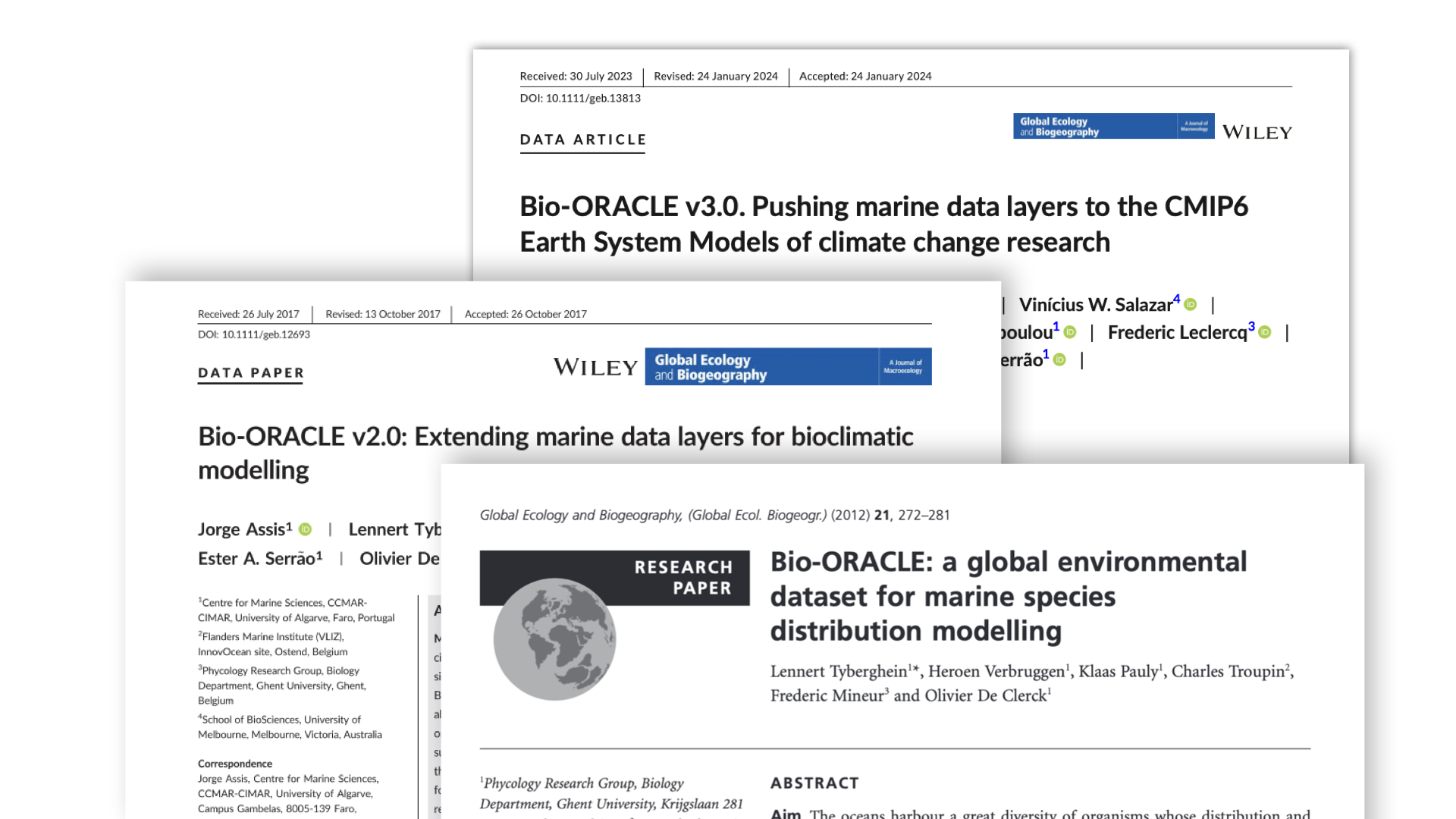Documentation on marine data layers
Get to know the details, methods and primary data sources of the marine data layers of Bio-ORACLE. These are documented in three peer-reviewed scientific publications.

Get to know the details, methods and primary data sources of the marine data layers of Bio-ORACLE. These are documented in three peer-reviewed scientific publications.

Bio-ORACLE provides 26 physical, chemical, biological and topographic marine data layers, with global coverage, uniform grid system, at a spatial resolution of 0.05 degrees, and a temporal resolution of 10 decadal steps, from 2000 to 2100.
* the average, maximum and minimum records of a given decade, long-term average of the yearly maxima and minima of a given decade (e.g., the average temperature of the warmest month in the period 2000-2010), and range, which represents the average absolute difference between the maximum and minimum records per year.
** because focal cells at 0.05 degree resolution comprise a wide range of depth values, the benthic layers were developed for the minimum, average and maximum depth within focal cells.
All layers are archived as NetCDF (network Common Data Form) and deposited into an ERDDAP server to facilitate filtering and downloading of the layers in common data formats. Additionally, Python (pyo_oracle) and R (biooracler) packages were developed for facilitated data retrieval and improved integration in available frameworks of bioclimatic modelling. Such packages act as clients for ERDDAP’s REST API, an interoperable web protocol for data transfer, and thus can be used for integration into most generic web-based applications.
All layers are archived as NetCDF (network Common Data Form) and deposited into an ERDDAP server to facilitate filtering and downloading of the layers in common data formats. Additionally, Python (pyo_oracle) and R (biooracler) packages were developed for facilitated data retrieval and improved integration in available frameworks of bioclimatic modelling.
Bio-Oracle layers are natively developed in NetCDF format. We provide a tutorial showing how to transform layers from NetCDF into GeoTIFF in R and Python.
To download multiple layers using biooracler R package you just need to make a simple loop that iteracts with the download_layers function. We provide example code for you to follow at github.com/bio-oracle/nc-multiple-layers-tutorial.
The surface layer in the raw Copernicus data refers to a very thin layer, ranging from 0 to 0.49 meters depth.
The benthic layers were produced with an interpolation process considering the geographic position and depth of cells, as inferred from a bathymetry layer. Since focal cells included a wide range of depth values, benthic layers are available for the minimum, average and maximum depths.
Big lakes and the Caspian Sea are outside of the scope of bio-ORACLE. There is however a publication that covers these regions: Lattuada, M., Wilke, T., and Raes, N.. 2020. Caspian Sea environmental variables: an extension of the Bio-ORACLE ocean data set. Ecology 101( 9):e03076. 10.1002/ecy.307610.1002/ecy.3076
We are not providing past data yet.
Under Bio-ORACLE v3, present is defined by the period 2000-2020, while under Bio-ORACLE v2 present is defined by the period 2000-2014.
This is not an abnormal phenomenon and it is described in the literature for the first years of simulations. RCP scenarios only start showing contrasting outputs from ~2050 onwards. Moreover, RCP45 is projected to be less intense than RCP26 for that period at global scales.
We are not providing data per year yet. Bio-ORACLE aims for the broad community of ecological modellers and the data provided are easy to use averages of long term extremes. You may find these data in Copernicus.
Assis, J., Fernández Bejarano, S.J., Salazar, V.W., Schepers, L., Gouvêa, L., Fragkopoulou, E., Leclercq, F., Vanhoorne, B., Tyberghein, L., Serrão, E.A., Verbruggen, H., De Clerck, O. (2024) Bio-ORACLE v3.0. Pushing marine data layers to the CMIP6 Earth system models of climate change research. Global Ecology and Biogeography. DOI: 10.1111/geb.13813
Assis, J., Tyberghein, L., Bosh, S., Verbruggen, H., Serrão, E. A., & De Clerck, O. (2017). Bio-ORACLE v2.0: Extending marine data layers for bioclimatic modelling. Global Ecology and Biogeography. DOI: 10.1111/geb.12693
Tyberghein L, Verbruggen H, Pauly K, Troupin C, Mineur F, De Clerck O (2012) Bio-ORACLE: A global environmental dataset for marine species distribution modelling. Global Ecology and Biogeography, 21, 272–281. DOI: 10.1111/j.1466-8238.2011.00656.x